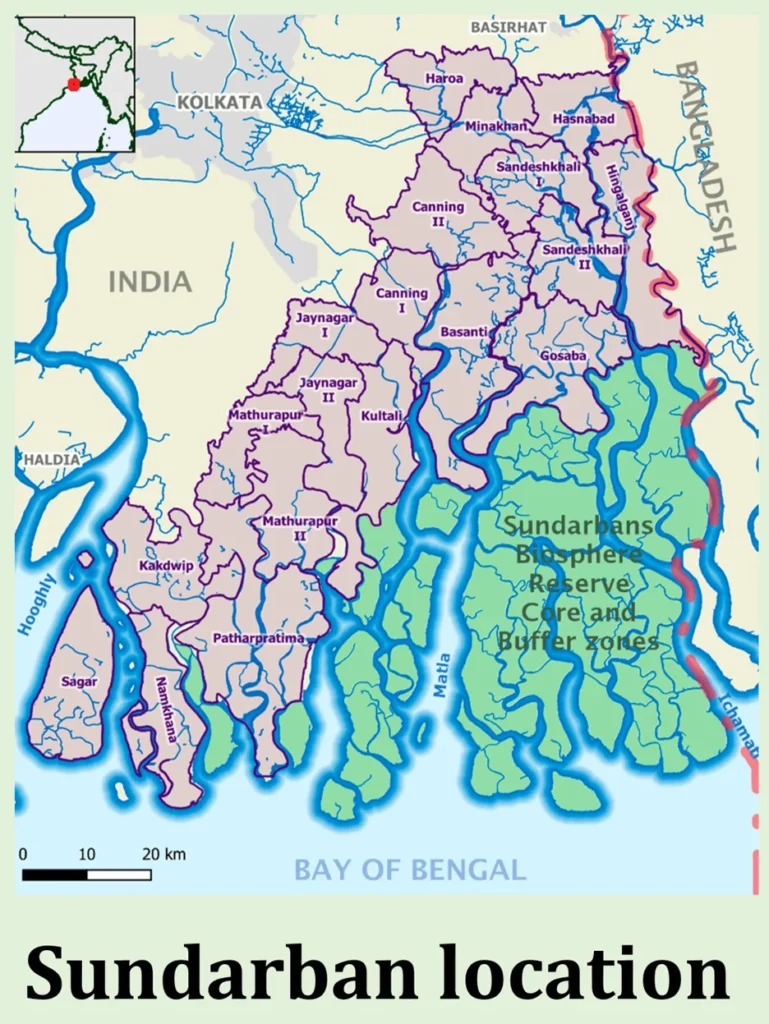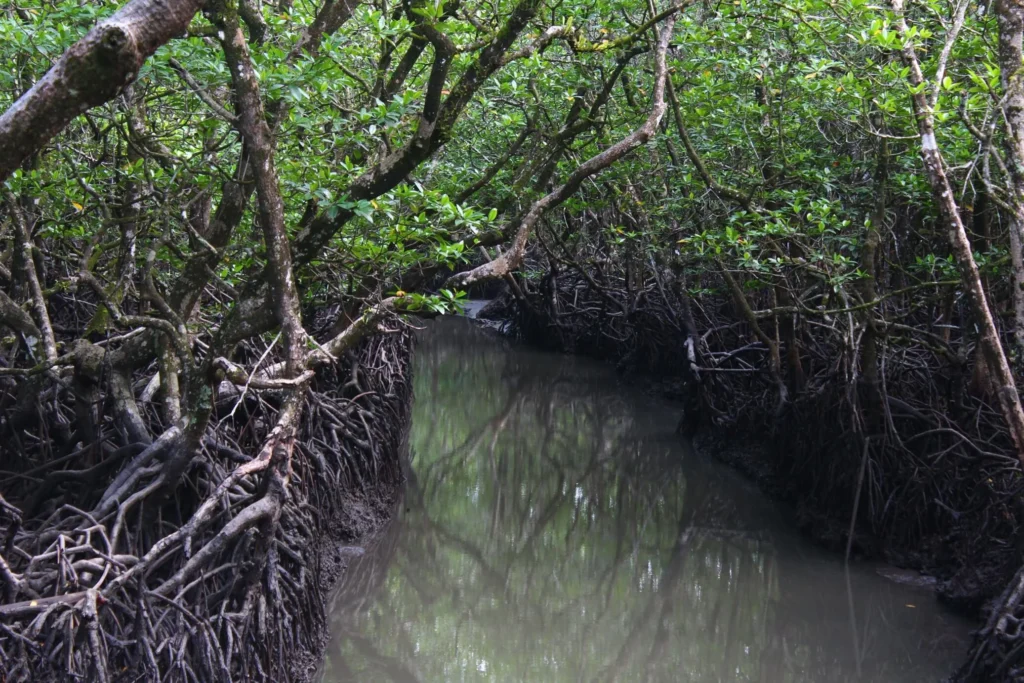
A Tour to the Sundarbans
The Sundarbans is a location situated at the meeting point of rivers and the Bay of Bengal. It comprises an expanse of mangrove trees stretching across both India and Bangladesh. Join me as we look at its incredible beauty and the importance it has.
Geographical Overview
It is located in the Gangetic delta spanning, around 10,000 kilometers. It is known for its network of meandering waterways dense mangrove forests and countless small islands. This mesmerizing combination of rivers, creeks and estuaries forms a scenery that captivates with its charm and enigma.

Historical Significance
The Sundarbans has a diverse history. It has always been a hub, for trade and business dating back to times. Over the years this region has experienced the ebb and flow of empires, European colonization and fights, for independence. The depths of the Sundarbans preserve tales, myths and remnants from the past giving it value.
The Relevance of Biodiversity
It is famous, for its variety of plant and animal life. It houses a range of species that are exclusive to this region. The dense mangrove forests provide a haven, for flora and fauna making the Sundarbans a crucial ecological asset.
Flora and Fauna of the Sundarbans
Rich Diversity of Plant Species
The Sundarbans is famous, for its collection of plant species with the mangroves serving as protectors. These remarkable trees not only provide homes for a variety of plants and animals but also have the incredible ability to thrive in waterlogged environment by effectively filtering out salt, from seawater.
The Importance of Mangroves in the Sundarbans
Its ecology is strongly reliant on mangroves to preserve its equilibrium. These distinctive trees provide refuge and breeding sites for a variety of wildlife, including birds, reptiles, and other species. Furthermore, their enormous root systems help to stabilize soil and protect beaches from wave erosion. Furthermore, these plants serve as breeding sites for species that help the fishing sector.
Fascinating Adaptations of Mangroves
Mangroves in the Sundarbans have evolved adaptations to thrive in their habitat. These trees breathe underwater thanks to modified roots known as pneumatophores. Their leaves have a waxy coating that minimizes water loss, and their large root systems give soil stability. The presence of these mangroves, in the Sundarbans showcases natures ingenuity through these adaptations.

Intriguing Animal Kingdom
It is home, to a range of animals each adapting uniquely to the mangrove forest. Among these the Royal Bengal Tiger stands out as both striking and highly skilled, at concealing itself.
The Special Royal Bengal Tiger
It is home, to the Royal Bengal Tiger, which holds a position of dominance. With a population of a few hundred remaining worldwide these tigers are incredibly rare. They have honed their swimming abilities. Frequently navigate through water to seek sustenance. Encountering one of these creatures, in their habitat is an extraordinary and infrequent occurrence. It shows how beautiful and special the Sundarbans really are.

Unique Wildlife Adaptations for Mangrove Life
Living in the mangrove ecosystem demands adaptations and the wildlife, in the Sundarbans serves as an example. Take the estuarine crocodile for instance. It has evolved to withstand both freshwater and saltwater environments positioning itself as a predator. Another intriguing case is the mudskipper, a fish that can breathe air and navigate on land. These instances truly showcase the adaptability of animals residing in the Sundarbans.
Migratory Birds: A Haven for Bird Lovers
It is like a paradise for people who really like birds and watching them. Every year, lots of birds that fly from far away come here and feel safe among the mangroves. Seeing colorful birds like Asian Openbills, Purple Herons, and Oriental Honey Buzzards makes nature lovers and photographers really happy.

Animals in Danger
The Sundarbans region is also a safe haven for marine creatures. However, a few of these creatures, like the Olive Ridley Sea turtles Irrawaddy dolphins and the renowned River Terrapin are facing the threat of extinction. Pollution, environmental alterations and the impact of climate change are posing risks to these species.
Conservation Efforts and Challenges
Conserving the Sundarbans is a battle because of complex obstacles. To effectively preserve this wonder, it is essential for governments, local communities and environmental organizations to collaborate. It is crucial to implement initiatives that focus on safeguarding and reviving mangrove habitats increasing awareness, about conservation efforts and addressing the issue of poaching. These measures play a role, in maintaining the biodiversity of the Sundarbans.
Living with the Sundari People
Indigenous Communities: The Sundari People
The Sundarbans is more, than a landscape; it also serves as the abode of the Sundari people an indigenous community deeply intertwined with this extraordinary location. These resilient societies boast a heritage. Share a profound bond with the mangroves that have provided sustenance, for them over many years.
Cultural Significance and Identity
For the Sundari people, the Sundarbans hold immense cultural significance. They believe that the mangrove forests are sacred and possess spiritual powers. Festivals and rituals are often centered around their relationship with nature, reinforcing their identity as guardians and protectors of this remarkable ecosystem.
Economy and Livelihoods
For generations the Sundari people have depended on the Sundarbans to sustain their way of life. Engaging in activities, like fishing, honey collection and crab farming ensures their stability. However, the growing threats to the mangrove ecosystem present challenges that must be addressed. Striking a balance between conservation efforts and the need for livelihoods is crucial for their community.
Social Challenges and Empowerment
The Sundari people encounter challenges, including limited access to healthcare and education services. Nevertheless, commendable initiatives have been undertaken to enhance their well-being through community driven projects. NGOs and governmental programs collaborate in providing healthcare facilities, educational opportunities and skill development training to uplift and empower the Sundari communities.
Environmental and Ecotourism Initiatives
Acknowledging the significance of eco practices the Sundari people wholeheartedly embrace environmental conservation efforts along with ecotourism initiatives. Actively participating in projects such as mangrove reforestation and ecotourism ventures enables them not to safeguard their surroundings but also create sustainable economic opportunities that align with the delicate ecosystem of the Sundarbans.
Development and Preservation
Placing development and preservation, at the core of their priorities is of utmost importance for the Sundari peoples future endeavors. They work hard to find a ground, between preserving the Sundarbans and promoting economic progress. Through the preservation of their heritage involvement in economic endeavors and endorsement of environmentally friendly practices they are creating a path, towards a better future that coexists harmoniously with their natural environment.
Ecotourism in the Sundarbans
Experiences for Nature Lovers
The Sundarbans is a destination, for nature lovers. It provides a variety of activities that cater to interests. You can enjoy the beauty of the mangrove forests embark on thrilling animal safaris or indulge in bird watching expeditions. Every new corner you discover within the Sundarbans reveals another awe-inspiring marvel.
Responsible Tourism Practices
In the Sundarbans, responsible tourist practices are critical. When you come to this destination it is crucial to be mindful of the surroundings and show respect, towards the residents. Being a conscientious traveler entails educating yourself about preservation efforts supporting the community and actively contributing to safeguarding this region.
Tourism’s Challenges and Prospects
Tourism gives economic possibilities to the Sundarbans, but it also presents difficulties. Mass tourism has the potential to cause damage, to the environment and indigenous communities. Therefore, ensuring the long-term preservation of this natural wonder necessitates implementing tourism strategies. These may include controlling the number of visitors implementing waste management systems and promoting the use of eco accommodations.
The Sundarbans: An Environmental Wonder
Climate Change and its Impacts
The Sundarbans, like other incredible natural marvels is not exempt from the consequences of climate change. The increasing sea levels and frequent weather events pose dangers, to the ecosystem of the Sundarbans. We must take action to limit the consequences of climate change and adapt to the changing environment. By doing so, we can assure the Sundarbans’ preservation for future generations.
Rising Sea and Land Erosion
The Sundarbans is facing an issue; the rising sea level. As the sea encroaches on the land, erosion occurs, causing the land to progressively decline. This mismatch between land and water endangers both the mangroves and the people who rely on them. To protect this region, it is critical to undertake land management techniques and aggressively reduce the effects of climate change.
Ensuring the Well-being of Wildlife and Plant Life in an Evolving Climate
It is of importance to prioritize the conservation of plant and animal species, within the Sundarbans particularly considering the changing climate. Everything in this area, like the trees, animals, and how things are physically, is all connected. To keep this balance safe, scientists are studying how climate change affects the Sundarbans. They’re working on ways to protect the diverse plants and animals by finding solutions to adapt to these changes.
Role of the Sundarbans in Ecosystem Services
The Sundarbans plays a role, in offering services to the ecosystem benefiting both the nearby communities and the global environment.
Carbon Sequestration and Climate Regulation
The mangroves of the Sundarbans have a role, in combating climate change because they serve as carbon sinks effectively capturing carbon dioxide from the atmosphere. Their capacity to store carbon makes them valuable partners in the fight against warming. Moreover, the thick vegetation plays a role in regulating the climate by offering shade moderating temperature fluctuations and acting as a barrier, against strong winds.
Protection against Natural Disasters
The Sundarbans serves as a barrier shielding the regions from calamities, like cyclones and tidal surges. The thick forests of mangroves. Disperse the power of winds and tidal waves thus lessening the impact on the land and minimizing the dangers to nearby communities. This vital role underscores the significance of preserving the Sundarbans as a safeguard, against the escalating perils posed by climate change.
Research and Study Opportunities
The Sundarbans offers a plethora of research and study possibilities, for scientists and environmentalists. Continuous scientific investigations and conservation initiatives provide insights, into facets of this distinctive ecosystem enhancing our comprehension of mangrove ecology, wildlife preservation and climate change adaptation. Collaboration, between international organizations is essential, for the collection of data sharing knowledge and the development of conservation strategies.
Summary
- The Sundarbans, located in the delta region of the Bay of Bengal is a marvel.
- It holds importance both geographically and historically.
- The Sundarbans is a haven, for plant and animal species showcasing an abundance of flora and fauna.
- The native Sundari community shares a bond with the mangroves valuing progress, for their preservation.
- When it comes to the Sundarbans ecotourism provides one-of-a-kind experiences that demand approaches.
- The Sundarbans holds significance in terms of climate control. The services it offers to ecosystems despite the challenges posed by climate change.
- To protect this ecosystem, it is essential to engage in research and promote collaboration.
Let’s fully embrace the beauty of the Sundarbans appreciating its marvels while actively striving to preserve it. By exploring this natural wonder, we can guarantee that future generations will have the opportunity to witness its magnificence and grasp the significance of safeguarding our delicate ecosystems for years ahead.
Frequently Asked Questions (FAQs)
How can I plan a visit, to the Sundarbans?
To explore the Sundarbans, you have options such as joining guided tours or hiring boats. It’s recommended to plan your visit in advance and make sure you have the permits and permissions.
Are there any safety measures for visitors?
Absolutely! Following safety guidelines provided by tour operators is essential. These may include wearing clothing using repellents and being cautious during boat rides.
What activities would you recommend in the Sundarbans?
I highly suggest going on mesmerizing cruises through the mangrove forests embarking on thrilling wildlife safaris and immersing yourself in bird watching experiences.
How can I contribute to conserving this area?
You can play a role in conservation efforts by supporting community led initiatives that focus on preserving the Sundarbans natural beauty. Additionally spreading awareness about its significance and engaging in eco practices will make an impact.
What are the significant threats faced by the Sundarbans ecosystem?
The Sundarbans ecosystem is currently facing challenges such, as climate change, habitat loss, pollution and unsustainable tourism practices. It’s crucial that we prioritize conservation efforts to mitigate these threats and protect the biodiversity found in this wonder.
